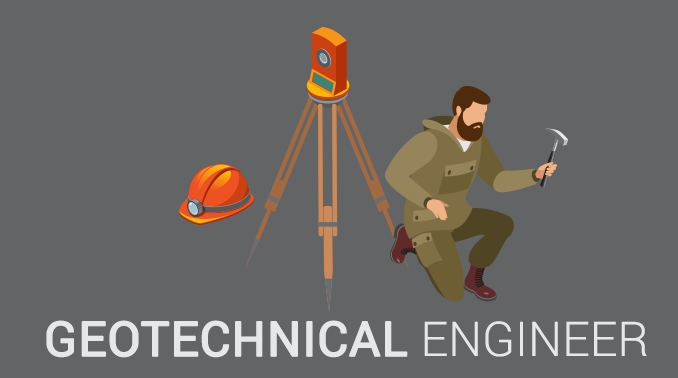The Ultimate Guide To Geotheta
The Ultimate Guide To Geotheta
Blog Article
The 9-Second Trick For Geotheta
Table of ContentsThe Geotheta StatementsThe smart Trick of Geotheta That Nobody is Talking AboutThe 6-Minute Rule for GeothetaSome Known Factual Statements About Geotheta
They work together with civil designers, structural engineers, architects, and various other specialists to incorporate geotechnical factors to consider into the overall project design and building and construction procedure. This needs efficient team effort, coordination, and communication to make certain that the geotechnical facets align with the project objectives and fulfill governing demands.Mining & Materials Engineering: Concepts of exploration, penetration prices, and variables impacting the choice of drilling method. Attributes of dynamites, firing systems and blast patterns. Blowing up methods in surface area and below ground workings. Unique blasting strategies at excavation boundaries. Vibration and sound control. Mechanical and continuous strategies to fragmentation, consisting of longwall shearing and fullface boring.
Modelling of piece and fragment size circulations; comminution as a transfer feature. Comminution modern technology: crushing, grinding, dimension classification. Integrated evaluation of fragmentation and comminution operations. Used by: Mining & Products Engineering.
The 9-Minute Rule for Geotheta
Bachelor's degree programs in civil, geotechnical, geological, and ecological design generally last 4 years and consist of basic education and learning training courses in English, social science, and the humanities, in addition to programs in sophisticated mathematics, structural geology, and fluid mineralogy. (https://www.easel.ly/browserEasel/14498559)
Geotechnical engineering includes the analysis of the soil and rock conditions at a certain website, and their ramifications for the growth of that website. As many frameworks depend on the ground for support, it lacks shock that a detailed understanding of the ground conditions, and the suitability of structure systems, are essential to the long-term stability and performance of the building or structure.
Being experts in the examination of geological formations and ground behaviour, geotechnical engineers do clinical investigations and testing to understand the impact these geological developments may carry the style and building and construction of building, civil and infrastructure tasks. This knowledge is essential for the style and building of buildings, roads, passages, dams, bridges, and water and sewer systems.
The geotechnical group at Douglas Partners routinely speak with architects, layout engineers, programmers, and contractors to make referrals on layout and growth proposals to make sure that the built frameworks are appropriately designed for the ground conditions. The style of footing systems needs to take into consideration the weight of the structure, the capacity of the ground to support that weight together with motion resistances and efficient building and construction.
Some Known Factual Statements About Geotheta
This task is significantly streamlined by the use our Douglas Map geospatial system which makes this information readily accessible in an easy to make use of internet browser user interface. A geotechnical engineer will certainly direct the drilling of boreholes and test pits to gather soil and various other samples, and additionally examine surface area functions and ground direct exposures to create a geotechnical version of the subsurface problems.
Depending upon the project type and ground conditions came across, lab testing may amongst various other things examine strength, compressibility, reactivity and/or permeability of soil and rock samples. After this data is accumulated and collated, the results are made use of for a geotechnical design of the site, which is commonly provided as areas across the site.

A geotechnical examination naturally can just assess the ground conditions at the locations drilled or dug deep into. All-natural variants in soil and rock problems can occur throughout a site and in between test places. It is therefore great method that the geotechnical designer be kept throughout construction of the project to supply on-site verification that the ground problems encountered are consistent with the expectations and advice given in the geotechnical examination report.
The Ultimate Guide To Geotheta
Geotechnical engineers use their in-depth expertise of soil and rock to evaluate danger and solve issues on varied infrastructure projectsGeotechnical design is a specialist branch of civil design which considers the behaviour of earth materials this and the application of soil and rock mechanics. Engineer of Record. As a geotechnical engineer, you will analyze the physical, mechanical and chemical residential properties of soil and rock in order to create foundations, keeping structures and earthworks
Geotechnical design is very closely connected to and overlaps with, both engineering geology and ground design - https://pubhtml5.com/homepage/jugmn/. It's feasible to be experts in geotechnics or benefit a geotechnical firm yet be called a design geologist or a ground designer. As a geotechnical designer, you'll require to: construct and maintain partnerships with clients and other specialists associated with the site, throughout each projectmaintain safety requirements on site bear in mind expense implications when you make recommendationsstudy geological maps and airborne pictures from a series of sources and from different time periodsexamine building and construction prepares to see how possible they are based on your understanding of the siteinvestigate risks or geological dangers for the sitesearch for environmentally sensitive features, such as landfill begin to create valid and interpretive ground modelsplan area investigationsdrill and analyse examples of bedrock, dirt, groundwater and extra materials supervise other experts on sitesolve technical concerns as they occur, such as unexpected structures at drill sitesmonitor conditions throughout and after construction to make certain frameworks are stable in the short and lengthy termadding data accumulated on site to your preliminary researchcreating geotechnical calculations, drawings, and 2 or three-dimensional computer models translating the datamaking recommendations concerning the suggested usage of the site

Report this page